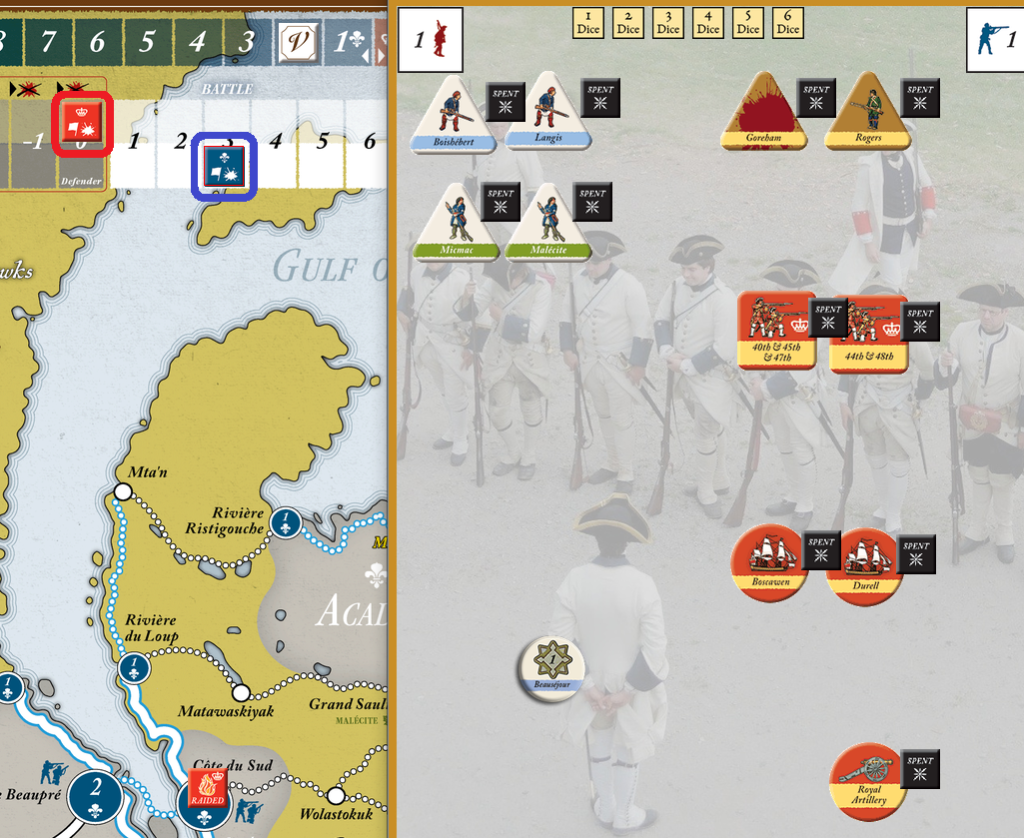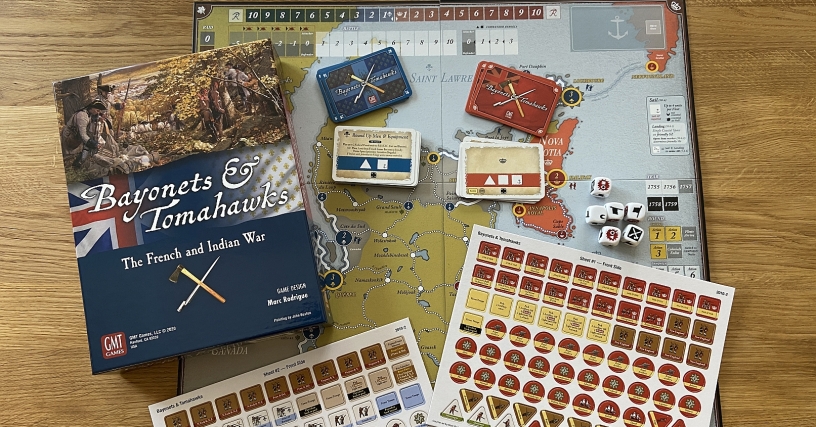GMT’s Bayonets & Tomahawks by Marc Rodrigue was a true discovery of 2021 for me. I played a lot – solo and two player, creating even some interesting material – I liked / like the game so much! So it was only matter of time when I attracted more and more of my boardgaming friends to this title.
One of them is definitely Dave with whom I had pleasure to play a lot of Combat Commander Europe. I asked if he would like to have a short break for something new and we decided that we will bring Bayonets & Tomahawks to the virtual table (well, we live like 6000 km apart so that is the only option 🙂 ) We played two scenarios using Vassal and had a real fun!
About the Game
But first things first. Let me tell you a little about the game. Bayonets & Tomahawks is a 2-player strategic game focusing on the French & Indian War 1755-1760 – colonial part of European 7-Years War. One player controls the British and the other controls the French and most Indians. Indian diplomacy, raids, constructions, naval operations, sieges: nothing is left out in order to immerse players in the fascinating military asymmetries of the 18th-Century colonial frontier.
So how does it play? B&T is card driven. Interestingly, unlike most card assisted war games player don’t manage a hand of cards. Each player starts the year with one undisclosed reserve Action card picked randomly. At the beginning of each Action round, both players draw a new card. They must then choose one of their 2 cards to play for the current round.
It is important to note that the game have various set-ups, from a very short, 1-turn scenarios to the full campaign. It really allows you to gradually learn it – and we started this exactly that way, from intro scenario.
Scenario 1 – Vaudreuil’s Petite Guerre (1755) – historical background
Let us focus now on the 1755 scenario historical background. It is pretty varied and complicated but let me briefly summarize it:
- Since 1749, the French authorities want to secure the link between their colonies of Canada and Louisiana via the Ohio River. French control of that area is contested by Virginia’s expansion. Tensions escalate, then the famous Jumonville incident, sparks open confrontation between Canada and Virginia.
- In the east, Massachusetts builds forts northward along the Kennebec river in Maine to protect its expansion from Canada and its Abenaki allies.
- Acadia and Nova Scotia are entangled in Father Le Loutre’s War since 1749, involving the Mi’kmaq people. Though no war is declared yet with France, the Royal Navy seizes French ships to deprive it of sailors for the war to come.
- Redcoat regiments are raised and sent to North America to attack New France. Louis XV gets wind of this plan and also sends regiments to Louisbourg and Québec.
Does it looks like a barrel of powder ready to be ignited by a single spark? Yes, it is and that is exactly what happened – the crawling conflict quickly escalated, both in America and Europe and involved multiple countries.
1755 Session Report
I am fan of picture-rich session reports and that will be no different. I will use the picture compare to show the set-up and developments of the game. Dave was leading French & Indian troops while I had a tough task of mobilizing the British for inevitable conflict. Let us see how it went!
Historically, the British succeeded in only one of their numerous objectives. Indigenous and French light units endangered the tenuous British supply lines. A wave of sustained raids devastated British colonial settlements all along the frontier. This is also exactly what happened in our game – it seems the history likes to repeat!


- The game started with numerous, usually successful, French and Indian raids on poorly defended British front towns and outposts; some of the larger (Northfield) were also reached.
- Then the first, unsuccessful British attack on Chignectou in the North commenced. Still, the fort held.
- The British were also using raid tactics – definitely not to the extent of French but still, some VPs were possible due to this.
- Seeing the huge Colonial army being amassed, French decided to entrench Niagara (fort was also build) and that way channel the British attack towards Montreal.
- In the meantime Red Coats again stormed Chignectou and again were repulsed with losses.
- Then, the climatic battle of Montreal ensued. French managed to bring reinforcements and rout the attacking British.

All in all, that was fun scenario to play with completely historical result (French victory). But the question was how long the French would withstand constant attacks and war of attrition with British should we continue?
Scenario 3 – Amherst’s Juggernaut (1758-1759) – historical background
Thanks to British Prime Minister William Pitt’s subsidies and equal treatment of colonial troops, overwhelming colonial forces join the war effort in 1758 (21,000 Provincial soldiers). Combined with these Provincials, the British have so many redcoats that they can field armies of 14,000 against one objective and 18,000 against another, not speaking of other operations… Numerically, New France is dominated. But it holds against desperate odds!
The Royal Navy has unprecedented numbers, dominating the oceans and maintaining an effective blockade of French ports. French reinforcements and supplies dwindle. But Canada draws on all available means to maintain its army and its indigenous allies in the field. Who will prevail?
1758-1759 Session report
This time we decided to change the sides and I was in charge of French & Indian forces, while Dave got a task of using the British for full-scale attack on French colonies. Again, you can see details in picture compare mode plus details of some interesting battles below. Let us see what happened!
PS. On set-up picture I added changes in comparison with Scenario 1.


- In Scenario 3 the Chignectou is already taken by British. What was worse, Dave started to build roads in two directions to further solidify the conquest. Due to pressure in the center and south, fortunately, he did not have time to finish!
- And pressure in the Southern and Central regions was enormous – multiple raids from Indians and French ravaged the British colonies – even despite better defenses and couple of forts.
- But the huge Colonial Army started to make its presence more and more visible. To the extent that they conquered the Ticonderoga fort, crushing French in the process.
- Before the attack on Montreal, British secured their left flank by sending some troops to Oswego and also starting to build the fort.
- And then the Red Coats launched an assault on Montreal which was bloodily repealed.
- A lot of interesting things were happening also in the deep South, where two roads allowed British to attacks twice Forks of Ohio. However, they were defeated by French both time.
Well, despite overwhelming British advantage in troops, it is not as easy to tackle the fort spaces – which Dave painfully learned. The raids allowed French to keep afloat which combined with islands of resistance (like Forks of Ohio or Montreal) allowed for their victory.
Summary
Interestingly, we had two French victories. While the first one in initial, 1755 scenario, was more or less probable, the early triumph in scenario 1758-1759 was a kind of surprise. The game played very well asynchronously, as there are no sudden interruptions, first strikes, reaction cards etc. The battles resolutions required some flexibility from us but all in all that was very enjoyable experience.
After moving to XVIII century we decided it is time to go back to what we love – and after above, we started again with Combat Commander!





Woo! I’d forgotten that this was probably upcoming. This is a great game that I’d love to play on the table some day. Of course, my military mind didn’t really get what I needed to do for attacking, but it was still quite fun.
Thanks for introducing me to it!
LikeLiked by 1 person
Thank for playing! I think we both had a lot of fun with it!
LikeLiked by 1 person
Great fun to read! I guess America speaks French now 😉
LikeLiked by 1 person
One wonders why history turned the other way round 🙂
LikeLike